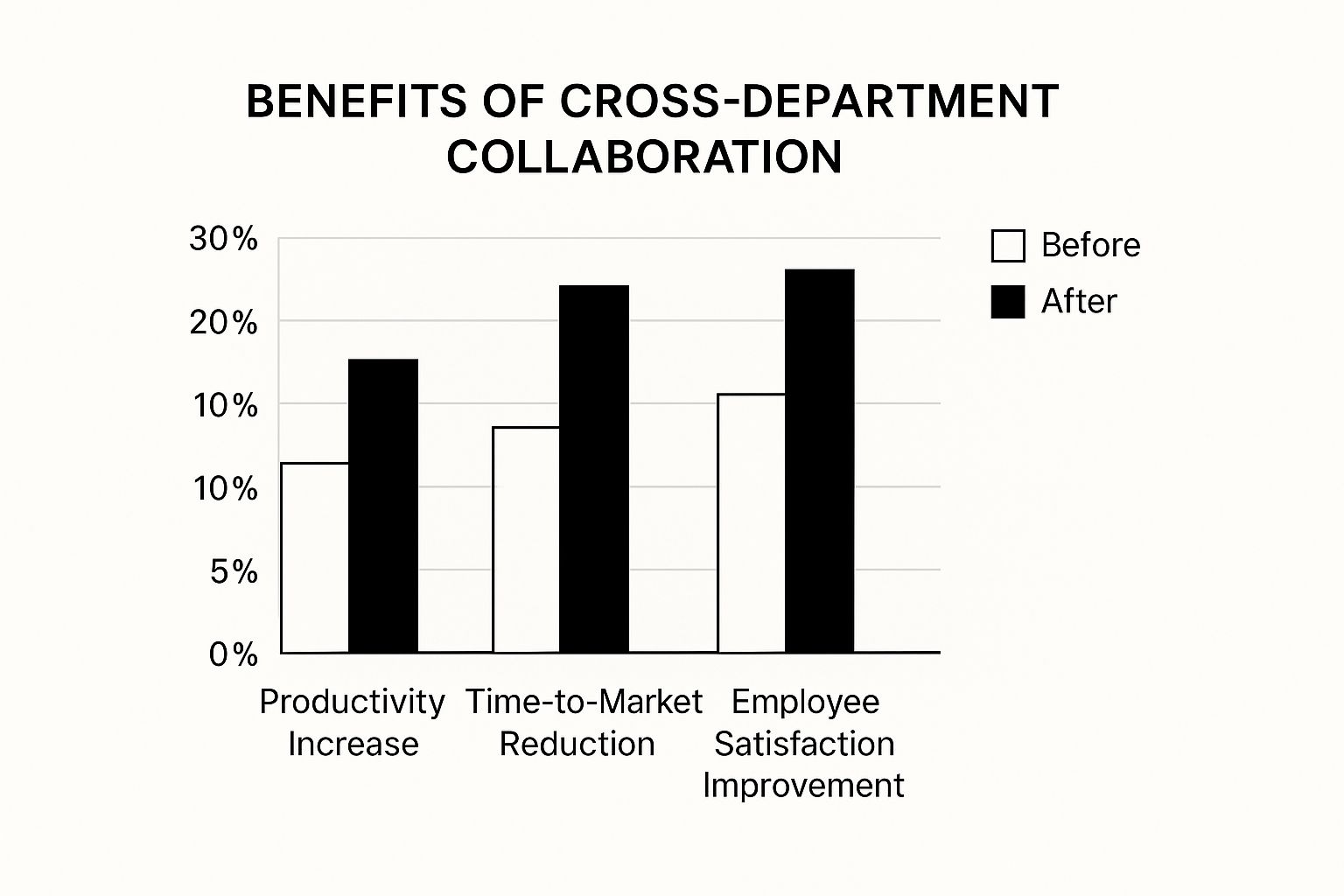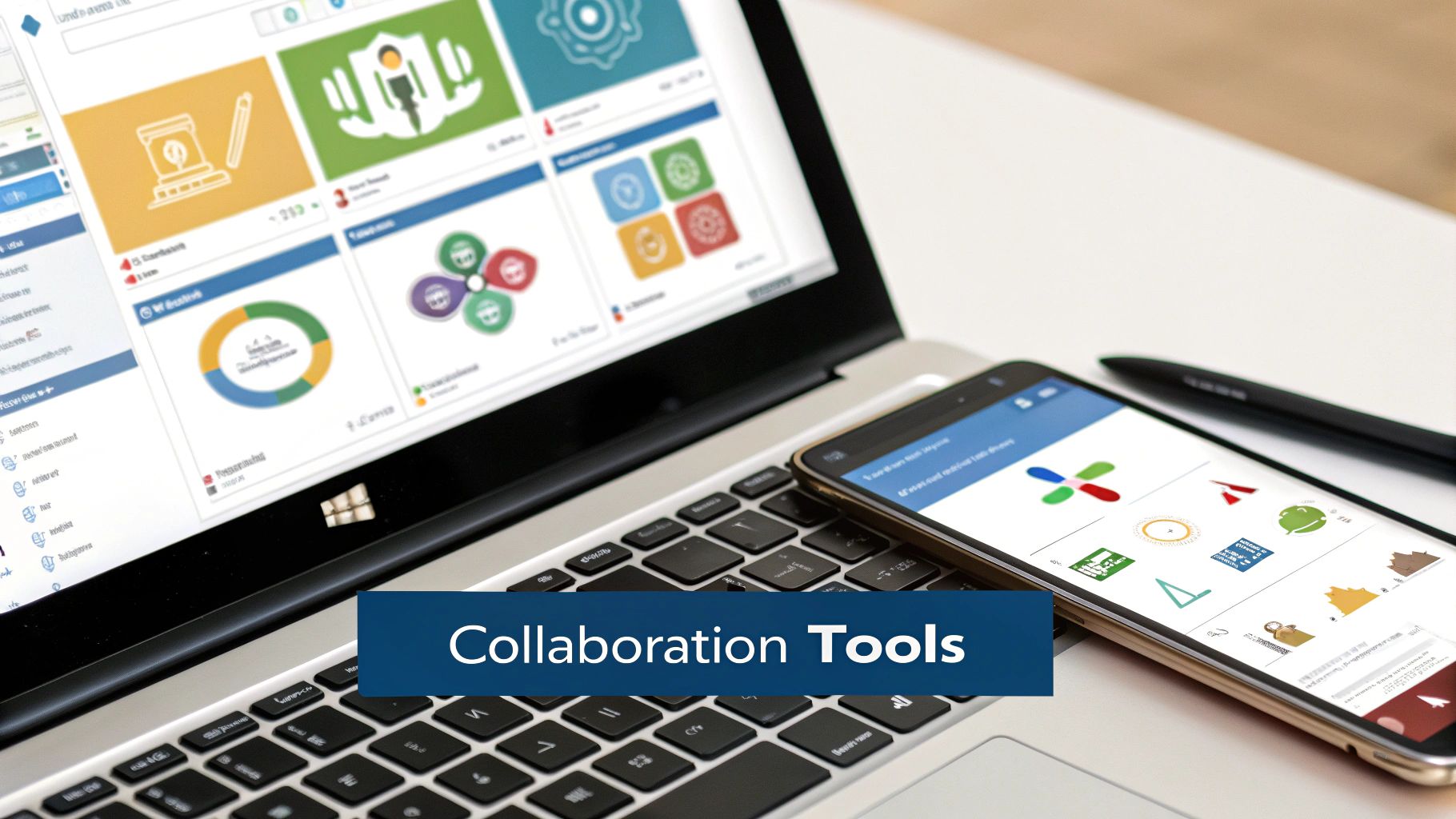What Cross-Department Collaboration Really Means

Let’s ditch the buzzwords. Cross-department collaboration boils down to removing the barriers that traditionally isolate teams within an organization. It’s not simply about improving teamwork; it’s about building a unified workflow where information flows seamlessly and everyone works toward common objectives. This integrated approach is especially vital for teams using both HubSpot CRM data and Jira workflows.
Imagine your support team fielding a customer complaint about a software bug. Typically, this might involve a chain of emails, internal messages, and perhaps a Jira ticket created days later. With effective cross-department collaboration, that customer interaction instantly generates a Jira issue, pre-filled with relevant HubSpot contact and company details.
This gives developers immediate insight into the customer’s history, leading to quicker, more effective solutions.
Benefits Beyond Issue Resolution
Seamless cross-department collaboration extends beyond immediate issue resolution. It fosters a shared understanding of customer needs across the organization. When sales, support, and product teams access the same real-time data, they can proactively address concerns, pinpoint areas for improvement, and ultimately, enhance the customer experience. Cross-departmental teamwork has fueled innovation and operational excellence in major companies. Apple’s iPhone, born from the cross-functional “Project Purple,” is a prime example. The iPhone now represents approximately 52% of Apple’s revenue. Learn more about the impact of cross-departmental collaboration here.
Challenges and Solutions
However, implementing and sustaining effective cross-department collaboration is a struggle for many organizations. Most initiatives fail within the first 90 days. Understanding these failures is crucial for cultivating a lasting collaborative culture. This requires more than just better communication; it necessitates a fundamental change in how teams interact and exchange information. The right tools are key to bridging the gap between intent and action.
Why Cross-Department Collaboration Falls Apart

The infographic above illustrates how better cross-department collaboration can significantly impact key business metrics. Improved collaboration can boost productivity by 25%, reduce time-to-market by 30%, and increase employee satisfaction by 15%. These compelling statistics highlight the real advantages of dismantling departmental silos.
While the potential benefits of cross-department collaboration are clear, many organizations struggle to make it work. Well-intentioned initiatives often encounter unexpected obstacles. This section explores why these collaborative efforts sometimes fail. For further reading, check out this helpful resource: How to master cross-functional team collaboration.
Communication Breakdowns and Conflicting Priorities
A major reason for collaboration failure is communication breakdown. When departments work in isolation, crucial information gets lost. This can lead to duplicated work, missed deadlines, and frustrated employees. Conflicting priorities also contribute to the problem, often creating friction between departments.
Sales teams are often focused on closing deals quickly. Meanwhile, support teams concentrate on resolving customer issues. And development teams work hard to manage the resulting influx of bug reports. This misalignment creates a cycle of stress and inefficiency.
For example, a sales team might unintentionally promise a feature that the development team is not yet working on, leading to disappointed customers and internal conflict. This highlights the importance of shared goals and clear communication channels.
Tool Silos and Data Disconnect
Another major obstacle to cross-department collaboration is the use of different software tools by different departments. This creates data silos and makes it difficult to see the complete picture of customer interactions or project progress. Important customer data collected by the sales team might not be readily available to the support team, impacting their ability to provide efficient assistance.
This lack of data integration makes it hard to track problems, measure progress, and identify areas for improvement. The following table breaks down some of the most common collaboration barriers and their impact on businesses:
To better understand the challenges organizations face, let’s take a closer look at some specific examples of collaboration barriers and their impact:
Top Collaboration Barriers and Their Business Impact: A breakdown of the most common obstacles to cross-department collaboration and their measurable effects on business performance.
| Collaboration Barrier | Impact on Productivity | Typical Cost to Organization |
|---|---|---|
| Communication Breakdowns | Decreased efficiency due to misunderstandings and duplicated efforts | Increased project costs, missed deadlines, lost revenue |
| Conflicting Priorities | Reduced focus on shared goals, wasted resources on competing initiatives | Delays in product development, decreased customer satisfaction |
| Tool Silos | Difficulty accessing and sharing information, hindering informed decision-making | Increased administrative overhead, inefficient workflows |
| Data Disconnect | Inability to gain a holistic view of customer interactions, impeding effective support | Loss of potential upselling/cross-selling opportunities, increased customer churn |
As this table demonstrates, these barriers can have a significant impact on an organization’s bottom line. Addressing these challenges is essential for fostering a collaborative and productive work environment.
The HubSpot-Jira Disconnect
One particularly challenging example is the disconnect between HubSpot and Jira. In organizations using both platforms, vital customer information is often confined within HubSpot, while development workflows reside solely in Jira. This separation creates a significant barrier to efficient cross-department collaboration.
When support teams in HubSpot receive customer complaints about bugs, relaying that information to the development team in Jira can be slow and prone to errors. This delay impacts the development team’s ability to fix issues quickly, ultimately increasing resolution times and negatively impacting customer satisfaction. Bridging this gap is essential for effective cross-department collaboration and to maximize the value of both HubSpot and Jira.
The HubSpot-Jira Bridge That Changes Everything
Want to see how different teams can work together smoothly? This section shows how connecting HubSpot CRM with Jira Software using the HubSpot for Jira app can break down barriers and simplify processes. This integration changes the way customer-facing and technical teams interact by giving them shared access to customer issues, development updates, and resolution times. For a deeper dive, check out this helpful guide: How to master the HubSpot-Jira integration.
Two-Way Synchronization: The Power of Shared Information
One of the best features of the HubSpot for Jira app is two-way field synchronization. This means any change made in HubSpot automatically shows up in Jira, and the other way around.
Imagine a support agent updating a customer’s contact information in HubSpot. With two-way sync, this update instantly appears in the connected Jira issue. This ensures everyone is using the most up-to-date information. No more manual updates, fewer errors, and one reliable source of data for all teams.
Automating Ticket Creation: From Customer Problem to Jira in an Instant
Another significant advantage is automatic ticket creation. When a customer reports a problem in HubSpot, a matching Jira issue is automatically created and filled with the relevant customer details.
This automation saves valuable time by eliminating manual data entry and making sure no important information gets lost. Development teams can then respond to customer problems quickly and efficiently.
Contact/Company Panel and Comment Mirroring: Keeping Everyone Informed
The HubSpot Contact/Company panel in Jira gives developers quick access to a customer’s complete history, including past interactions and support requests.
This comprehensive overview helps developers understand the background of each issue, allowing for faster and more effective solutions. Comment mirroring also ensures all communication between HubSpot and Jira is synced. When a support agent adds a comment in HubSpot, it automatically shows up in the linked Jira issue, keeping everyone updated.
Implementing the HubSpot for Jira App: A Simple Guide
Ready to get started? Here’s how to set up the HubSpot for Jira app from the Atlassian Marketplace:
- Step 1: Install the HubSpot for Jira app from the Atlassian Marketplace.
- Step 2: Connect your HubSpot and Jira accounts.
- Step 3: Configure the two-way field synchronization between HubSpot and Jira issues. Focus on syncing important fields like customer name, contact info, and issue description.
- Step 4: Set up automation rules to automatically create Jira tickets from HubSpot customer issues.
- Step 5: Customize the HubSpot Contact/Company panel in Jira to display the most relevant customer information.
- Step 6: Enable comment mirroring for seamless communication between HubSpot and Jira.
Following these steps will unlock the potential of cross-department teamwork and transform your workflows. Teams will have access to real-time data, simplified communication, and a shared understanding of goals. The result? Increased efficiency, happier customers, and a more collaborative work environment. This is more than just connecting tools; it’s about connecting teams and building a foundation for shared success.
Strategies That Actually Improve Team Collaboration

Connecting HubSpot and Jira is a solid starting point, but technology alone won’t transform team dynamics. Genuine cross-department collaboration thrives on a shared vision, open communication, and mutual respect. It’s a transition from siloed departments to integrated teams working towards common goals.
Shared Accountability: Moving Beyond Departmental Silos
One powerful strategy is fostering shared accountability. This involves dismantling departmental silos and making teams jointly responsible for key objectives. When success hinges on the combined efforts of multiple departments, individuals are more inclined to communicate effectively and collaborate seamlessly.
For example, instead of solely evaluating sales performance based on closed deals, consider incorporating the speed at which support teams resolve customer issues related to those deals. This shared accountability cultivates a sense of collective ownership and encourages a more holistic approach to problem-solving.
Establishing Communication Rhythms That Work
Effective communication is the cornerstone of cross-department collaboration. However, excessive meetings can be detrimental. Instead of endless email chains and status updates, establish clear communication rhythms that respect everyone’s time.
This might involve brief, daily stand-up meetings for quick updates, supplemented by weekly in-depth discussions for complex issues. The aim is to keep everyone informed without unnecessary interruptions, fostering a balance between communication and focused work.
Measuring What Matters: Focusing on Shared Metrics
Tracking the success of cross-department collaboration requires defining and monitoring relevant metrics. These metrics should reflect shared goals and offer a clear picture of overall progress.
For instance, companies emphasizing cross-functional teams often experience improvements in efficiency and innovation. Research suggests that such teams can reduce delivery times by up to 30% and boost customer satisfaction by as much as 25%. Find more detailed statistics here. Rather than focusing solely on individual departmental goals, consider tracking overall customer satisfaction, time-to-market, or project completion rates. These shared metrics provide a comprehensive view of performance.
Maintaining Momentum: The Long-Term Vision
Successful cross-department collaboration is an ongoing journey, not a one-time fix. It necessitates consistent effort, regular check-ins, and a willingness to adapt strategies as needed.
Celebrate successes together. Recognizing and rewarding collaborative achievements reinforces the value of teamwork and encourages continued engagement. When challenges inevitably arise, view them as learning opportunities. This commitment to continuous improvement is essential for long-term success. By embracing these strategies, organizations can cultivate a collaborative environment that fuels innovation, enhances efficiency, and elevates the customer experience.
Real Success Story: From Silos to Seamless Workflow

Imagine a software company, Innovate Inc., grappling with the all-too-common problem of departmental silos. Support tickets went unanswered, frustrated customers left, and the blame game between support and development teams became routine. Does this sound like a familiar scenario? Innovate Inc.’s journey highlights the practical challenges and ultimate successes of implementing effective cross-department collaboration.
The Before: A Story of Frustration and Inefficiency
Before embracing true cross-department collaboration, Innovate Inc. operated in a constant state of conflict. Using HubSpot CRM, customer support agents faced a deluge of complaints about software bugs. Meanwhile, the development team, using Jira, struggled to manage the disorganized influx of bug reports. Strong teams are built on solid foundations. For valuable insights on team building, check out this resource on building a strong team.
This disconnect led to delayed responses, unresolved issues, and increasing customer dissatisfaction. Support agents felt ignored, developers felt overwhelmed, and customers felt abandoned. Clearly, a change was necessary.
The After: HubSpot for Jira as the Bridge
Innovate Inc.’s breakthrough came with the adoption of HubSpot for Jira. This integration revolutionized their workflow by connecting the previously separate HubSpot and Jira platforms. Now, support agents could seamlessly create Jira tickets directly within HubSpot, complete with all the necessary customer information.
This instant data transfer allowed developers to quickly grasp the context of each issue, resulting in faster resolutions and improved customer satisfaction. The two-way synchronization ensured that updates in either platform were instantly reflected in the other, eliminating manual updates and minimizing errors.
Measurable Results and Unexpected Benefits
The impact of HubSpot for Jira on Innovate Inc. was substantial. Response times decreased by 40%, and customer satisfaction scores increased by 20%. Perhaps most significantly, team morale saw a dramatic improvement. The smooth flow of information fostered a shared sense of purpose and empowered both support and development to work together effectively.
The journey wasn’t entirely smooth, however. Initially, the team encountered difficulties configuring the field mappings between HubSpot and Jira. Overcoming this obstacle required dedicated training and consistent support from their resolution team. This experience highlights the importance of not just selecting the right tools, but also investing in proper implementation and training.
Lessons Learned: The Path to Sustainable Transformation
Innovate Inc.’s story proves that successful cross-department collaboration requires more than just new technology. It demands a commitment to open communication, shared responsibility, and a willingness to adapt. HubSpot for Jira provided the connection, but it was the team’s dedication to change that paved the way for lasting success. Their experience offers valuable lessons for any organization aiming to break down silos and create a truly collaborative environment.
Best Practices for Lasting Collaboration Success
Connecting your HubSpot and Jira instances is a significant first step. It sets the stage for better communication and more streamlined workflows between teams. But real, lasting success in cross-department collaboration requires more than just connecting software. It demands a consistent effort to cultivate a collaborative culture.
This section explores key practices to help your teams solidify initial gains and build a thriving collaborative environment.
Maintaining Communication Quality: Beyond the Initial Buzz
The initial enthusiasm surrounding a new system can fade. It’s crucial to maintain momentum and prevent communication from reverting to old, less efficient habits. Regularly scheduled touch-base meetings between departments can help.
These meetings should be focused on proactive problem-solving and knowledge sharing, not just status reports. Consider exploring different communication strategies to keep things fresh and engaging. Check out this company’s Contact page for more ideas.
Navigating Conflicting Priorities: Avoiding Turf Wars
Conflicting priorities are unavoidable in any organization. The key is to establish clear escalation paths and decision-making processes to handle these conflicts constructively. This involves creating a framework where disagreements are seen as opportunities for finding organization-wide solutions, not as departmental “turf wars.” When conflicts arise, focus on shared goals and encourage open discussion.
Measuring Collaboration Effectiveness: Data-Driven Insights
Improvement requires measurement. Tracking the right metrics will illuminate the impact of your cross-department collaboration initiatives. Choose metrics aligned with your overall business goals, such as improved customer satisfaction, faster resolution times, or increased sales conversion rates. Review these metrics regularly to pinpoint areas for improvement and highlight the value of collaboration. For a deeper dive into effective data strategies, check out this resource on data integration best practices.
Building Shared Accountability: From Forced to Organic
Shared accountability isn’t about assigning blame. It’s about nurturing a sense of collective ownership. Define clear roles and responsibilities, but also emphasize the interconnectedness of different departments. Encourage teams to work together towards shared outcomes, recognizing that individual successes contribute to the organization’s overall achievements.
Establishing Escalation Processes That Work
Efficient escalation processes are crucial for handling roadblocks. Create a clear framework for escalating issues, outlining who to contact and the proper communication channels. Ensure everyone understands and feels comfortable using this process. This empowers teams to tackle challenges quickly without getting stuck in bureaucratic red tape.
To help guide your implementation of these practices, consider the following checklist:
Introducing the “Cross Department Collaboration Implementation Checklist.” This table outlines the key steps for implementing and maintaining effective collaboration across your departments, along with the metrics to measure success.
| Implementation Phase | Key Actions | Success Metrics |
|---|---|---|
| Initial Setup | Implement communication tools (e.g., Slack), establish regular meeting cadence | Increased interdepartmental communication frequency |
| Conflict Resolution | Define escalation paths and decision-making processes | Reduced time to resolve interdepartmental conflicts |
| Performance Measurement | Identify and track key performance indicators (KPIs) | Measurable improvements in chosen KPIs (e.g., customer satisfaction, resolution times) |
| Ongoing Maintenance | Regular review of processes, feedback gathering, and adjustments as needed | Consistent performance against established KPIs, positive feedback from team members |
This checklist provides a starting point for building a stronger collaborative environment. Remember to adapt it to your specific organizational needs.
Creating Collaborative Habits: Embedding Collaboration in Your DNA
True cross-department collaboration is a cultural shift, not a one-time project. It requires embedding collaboration into the everyday routines and habits of your teams. Foster open communication, knowledge sharing, and mutual support. Celebrate successes together and view challenges as shared learning opportunities.
By consistently implementing these best practices, you can build a sustainable and adaptable collaborative environment. This ongoing commitment to teamwork will drive continuous improvement and empower your organization to reach its strategic goals.
Try HubSpot for Jira free → https://www.resolution.de/hubspot-for-jira
